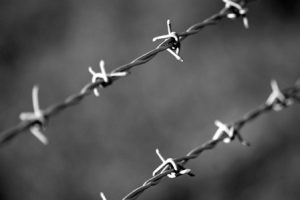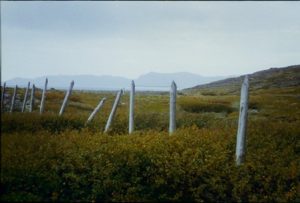A boundary fence doesn’t fail overnight.
It’s the subtle signs that warn you first.
If ignored, small cracks in the system can snowball into major breaches.
Walk the perimeter regularly, scanning for issues like sagging wires, corroded metal, or leaning posts.
 Keep your ears sharp too: a fence that shifts or rattles in high winds might hint at compromised tension. Pay attention to how animals behave around your fence; cattle or sheep hovering near one spot may indicate a weak section they’re testing.
Keep your ears sharp too: a fence that shifts or rattles in high winds might hint at compromised tension. Pay attention to how animals behave around your fence; cattle or sheep hovering near one spot may indicate a weak section they’re testing.
Don’t just visually inspect-run your hand along the wire to feel for rust or fraying that isn’t immediately visible.
Inspect where wire fastens to posts; tension often fails first in these areas due to stress concentration. After major weather events, like storms or heavy frost, perform a detailed post-check to catch weather-induced damages early.
For precise performance checks, measure wire sag with a tension gauge. Ideally, tension for high-tensile wire should be maintained between 150 to 250 pounds of force, depending on the wire type and application.
A farmer I know discovered this when his livestock escaped. What looked like a harmless loose post had allowed the wire tension to slacken across an entire section.
He spent days rounding up his cattle-a problem that a ten-minute check could’ve prevented. Additionally, he later installed fence stabilisers in vulnerable corners to prevent recurrence.
Early detection of small damages prevents bigger, costlier repairs later. Regular touch inspections, tension monitoring, and post-weather checks add further security.
How Can You Preserve Wire Tension for the Long Haul?
 A well-tensioned fence isn’t just for aesthetics-it’s vital for functionality.
A well-tensioned fence isn’t just for aesthetics-it’s vital for functionality.
Over time, wire loses tension due to environmental factors like temperature shifts.
Expansion during hot summers and contraction in freezing winters stretch the wire beyond its original shape.
This repeated strain leads to sagging, which compromises both security and containment. High-tensile wire, known for its greater elasticity and strength, can handle these fluctuations better but still requires routine adjustments.
If within budget, consider getting a local fencing company to undertake the initial installation. Invest in tensioners or turnbuckles, which allow you to tighten wire without needing to completely re-string it. These devices work best when placed near anchor points, such as corners and gateposts, where wire stress accumulates. Ensure that the wire is strung evenly and without kinks to prevent points of failure. Use a fence tension gauge to precisely monitor tension instead of relying on guesswork.
Stretch the wire to about 75% of its breaking capacity-typically between 1500 and 2000 pounds for standard 12.5-gauge high-tensile wire-to account for seasonal slack.
Keep in mind that over-tensioning weakens wire at fastening points and posts, eventually leading to snapping. When tensioning, brace yourself at an angle and gradually apply force to prevent wire whiplash-a common hazard during maintenance.
When I helped a rancher reinforce his fencing, he learned the hard way that overtightening can cause wires to snap, costing both time and materials. Since then, he’s adopted a practice of re-tensioning only in cooler weather when wire contracts naturally, preventing excess strain.
Consistent tension prevents future sagging and ensures your fence stays intact (source). Use proper tools and seasonal timing for safe, effective tensioning.
What Tools and Equipment Are Must-Haves for Maintenance?
 Think of maintaining a fence like maintaining a vehicle: without the right tools, you’re left stranded. Essential items include:
Think of maintaining a fence like maintaining a vehicle: without the right tools, you’re left stranded. Essential items include:
- Wire cutters: For cleanly trimming and removing damaged sections; invest in models that can handle up to 12-gauge high-tensile wire. Maun have a range of combination pliers designed to handle high-tensile fencing wire, with the benefit of not having to swap between tools when bending and cutting.
- Tensioners or stretchers: To restore sagging wire to proper tautness.
- Post driver: Speeds up the installation of new posts and reinforces loosened ones; models with shock absorption reduce operator fatigue.
- Protective gloves: Prevent injuries from sharp wires and splinters.
- Anti-rust treatments: Keep corrosion at bay in high-risk areas.
- Measuring tape: Ensures accurate post spacing and tension distribution.
One farmer shared how he tried to save money by skipping professional tools. Unfortunately, makeshift solutions slowed his repairs and worsened the damage. He now swears by an annual investment in tool upgrades to prevent similar setbacks.
Takeaway: Investing in proper tools ensures efficient, long-lasting repairs while reducing downtime.
Why Are Fence Posts the Backbone of Your Boundary?
 Imagine a concert without proper scaffolding-chaos, right?
Imagine a concert without proper scaffolding-chaos, right?
That’s your fence without solid posts. Every wire relies on these anchor points to hold steady. Weak or misaligned posts create ripple effects, compromising the entire structure’s integrity.
Even the toughest wire will fail if posts shift due to soil erosion or mechanical strain.
Posts should be buried to the appropriate depth-about one-third of their total length for standard soil and up to half their length in sandy or marshy ground (source).
For example, an 8-foot post should be buried at least 2.5 to 4 feet deep, depending on soil stability. When setting wooden posts, treat the buried portion with a preservative to prevent rot. Concrete footings around metal posts provide added stability but can become a liability if water collects and accelerates corrosion.
For corner posts, diagonal bracing with tension rods or crossbars provides extra strength to resist pulling forces. A properly braced corner post can handle upwards of 2000 pounds of tension per wire. Additionally, staggered post placement on uneven terrain helps maintain tension along slopes. If your land is prone to frost heave, install flexible base supports that absorb vertical movement.
A business owner managing a remote property saw vandalism increase after shifting soil loosened several key posts. Reinforcing his anchors with concrete collars immediately curbed the issue. Since then, he inspects post alignment quarterly to stay ahead of structural weaknesses.
Takeaway: Strong, stable posts are essential to withstanding environmental pressures, terrain shifts, and security risks.
What Can You Do About Rust and Corrosion?
 Rust is your wire fence’s worst enemy, especially in regions with high humidity, frequent rainfall, or salt exposure.
Rust is your wire fence’s worst enemy, especially in regions with high humidity, frequent rainfall, or salt exposure.
Corrosion starts microscopically but accelerates once cracks in protective coatings allow moisture in (source).
Left unchecked, rust can reduce wire strength by up to 50%, rendering even a high-tensile fence ineffective.
Start with galvanised or stainless-steel wire, which resists rust better than bare steel. For added protection, apply anti-corrosion coatings, such as zinc-rich sprays, to areas most exposed to moisture, such as joints and anchor points. Use rubber or plastic insulators where wire touches metal posts to minimise electrochemical reactions.
Ensure proper drainage around posts to prevent water accumulation. Grade the area around your fence line and install gravel beds at least 6 inches deep to channel rainwater away from base points. Inspect wire for signs of rust streaks or pitting during routine checks and immediately replace compromised sections.
A client near the coast replaced her fencing material after corrosion ruined an entire section within two years. Switching to high-tensile galvanised wire, combined with scheduled anti-corrosion treatments, saved her from annual replacements.
Takeaway: Preventative measures against rust extend your fence’s lifespan and reduce long-term maintenance costs.
How Can You Prevent Wildlife and Intruder Damage?
 A fence isn’t just a divider; it’s a deterrent. But wildlife and intruders test its defences constantly. Wild animals like deer and boars push through or jump over weak spots, while burrowing creatures undermine posts. Human trespassers may tamper with wires, cut openings, or attempt to climb over.
A fence isn’t just a divider; it’s a deterrent. But wildlife and intruders test its defences constantly. Wild animals like deer and boars push through or jump over weak spots, while burrowing creatures undermine posts. Human trespassers may tamper with wires, cut openings, or attempt to climb over.
Strengthen your fence with multiple deterrents tailored to specific threats. Bury a portion of the wire 12-18 inches below ground level to discourage digging. Add barbed or electrified wire at the top to prevent climbing. Maintain visibility lines along the fence to deter hidden breaches.
For electrified fencing, use energisers that output between 4000 and 7000 volts, depending on the threat level (source). For high-security areas, consider motion-triggered lights or surveillance cameras. Even simple signage warning of electric fencing can psychologically deter potential trespassers. One security contractor recounted how a strategically placed trail camera caught repeated tampering attempts, allowing swift intervention.
Takeaway: Reinforcing weak points and adding both physical and psychological deterrents enhances both security and peace of mind.
When Should You Replace Wire Instead of Repairing It?
 At what point do you stop patching and start replacing? Minor damages like isolated breaks or small rust spots can often be mended. However, extensive rust, multiple wire fractures, or large sections of sagging indicate it’s time for a full replacement.
At what point do you stop patching and start replacing? Minor damages like isolated breaks or small rust spots can often be mended. However, extensive rust, multiple wire fractures, or large sections of sagging indicate it’s time for a full replacement.
High-tensile wire typically lasts 20 to 30 years with proper care. Yet, extreme conditions-such as regular flooding, severe frosts, or chemical exposure-can accelerate wear. Periodic stress testing, where sections of wire are pulled taut to check for brittleness or microfractures, can reveal hidden weaknesses.
Replacement decisions should also account for costs. For example, repairing three or more fractured sections in a 200-metre stretch may exceed the cost of replacing the entire segment.
A rancher I worked with delayed replacing rusted wire for years, resulting in costly livestock escapes and repeated emergency repairs. His eventual full replacement paid for itself within a season due to reduced upkeep and increased reliability.
Takeaway: Recognising when to replace instead of repair saves time, money, and frustration. Stress testing wire can reveal hidden weaknesses before they fail.
How Do You Handle Maintenance in Extreme Weather?
 Weather conditions dramatically affect fence durability. Heavy rains can erode soil around posts, while high winds stress wire tension. Ice buildup in colder climates can weigh down wires, causing them to sag or snap. Additionally, ultraviolet (UV) rays degrade plastic components over time.
Weather conditions dramatically affect fence durability. Heavy rains can erode soil around posts, while high winds stress wire tension. Ice buildup in colder climates can weigh down wires, causing them to sag or snap. Additionally, ultraviolet (UV) rays degrade plastic components over time.
Schedule inspections after severe weather events to catch damage early. In hot climates, tension your fence during cooler parts of the day to avoid over-tightening. Conversely, in cold regions, leave a bit of slack to accommodate winter contraction without risking wire breakage. Ice guards, which cost around £10-15 per unit, can protect key points from freezing damage.
After a storm, a rancher I knew discovered half his fence had collapsed from flooding. His quick post-storm assessment saved him from further livestock escapes and gave him an opportunity to improve drainage along the fence line.
Takeaway: Adapt your maintenance strategy to seasonal and extreme weather challenges to minimise damage. Weather-resilient designs pay off in the long term.
What’s the Best Way to Keep a Maintenance Log?

A structured log might seem excessive until you’re trying to remember when you last tightened a section or replaced wire. Regular record-keeping helps spot patterns and predict future issues, giving you a proactive maintenance plan.
Include details like inspection dates, repairs made, materials used, and weather conditions. For large properties, divide the fence into sections and track each separately. Apps or spreadsheets simplify this process and reduce paperwork. Over time, you’ll gain insights into common failure points and seasonal stress factors.
For accuracy, update logs within 24 hours of performing work. Cross-reference with local weather reports to identify correlations between conditions and damage occurrences.
A security manager at a logistics company used maintenance logs to optimise repairs. He noticed that sections exposed to direct sun needed more frequent tension adjustments, allowing him to allocate resources more efficiently. His system ultimately reduced emergency callouts by half.
Maintenance logs turn reactive fixes into proactive solutions, saving you both time and money.
By understanding these crucial aspects of wire fence care, you’re better equipped to maintain strong, resilient boundaries-whether keeping assets in or threats out. Now, how will you take control of your fence maintenance today?
